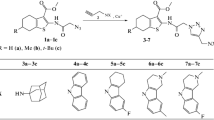Summary
The effects of calmodulin (CaM) antagonists (W-7, W-5, trifluoperazine, chlorpromazine, quinacrine, diazepam, propericyazine and carmidazolium) on the sodium and potassium channels were studied on the intracellularly perfused and voltage-clamped giant axon of the squid. It was found that the drugs are more potent blockers of the sodium current than of the potassium current. The drugs also reduce the sodium gating current. The blockage of the sodium and gating current can be explained by assuming that the drugs interact with the sodium gating subunit in one of its closed states. The site of action is probably the intracellular surface of the axolemma where presumably a Ca2+-calmodulin complex can be formed.
Similar content being viewed by others
References
Asano, M., Hidaka, H. 1984. Biopharmacological properties of naphthalenesulfonamides as potent calmodulin antagonists.In: Calcium and Cell Function. Vol. 5, pp. 123–164. W.Y. Cheung, editor. Academic, New York
Bezanilla, F., Armstrong, C.M. 1977. Inactivation of the sodium channel. I. Sodium current experiments.J. Gen. Physiol. 70:549–566
Bezanilla, F., Taylor, R.E., Fernandez, J.M. 1982. Distribution and kinetics of membrane dielectric polarization. I. Longterm inactivation of gating currents.J. Gen. Physiol. 79:21–40
Dillingham, M.A., Dixon, B.S., Kim, J.K., Wilson, P.D. 1986. Effect of trifluoperazine on rabbit cortical collecting tubular response to vasopressin.J. Physiol. 372:41–50
Ellisman, M.H., Porter, K.R. 1980. Microtrabecular structure of the axoplasmic matrix, visualization of cross-linking structures, and their distribution.J. Cell Biol. 87:464–479
Katz, G.M., Schwartz, T.L. 1974. Temporal control of voltage-clamped membranes: An examination of principles.J. Membrane Biol. 17:275–291
Keynes, R.D., Greeff, N.G., Van Helden, D.F. 1982. The relationship between the inactivation fraction of the asymmetry current and gating of the sodium channel in the squid giant axon.Proc. R. Soc. London B 15:391–404
Kobayashi, T., Tsukita, S., Tsukita, S., Yamamoto, Y., Matsumoto, G. 1986. Subaxolemmal cytoskeleton in squid giant axon. I. Biochemical analysis of microtubules, microfilaments, and their associated high-molecular-weight proteins.J. Cell Biol. 102:1699–1709
Lackington, I., Orrego, F. 1981. Inhibition of calcium-activated potassium conductance of human erythrocytes by calmodulin inhibitory drugs.FEBS Lett. 133:103–106
Matsumoto, G. 1976. Transportation and maintenance of adult squid (Doryteuthis bleekeri) for physiological studies.Biol. Bull. 150:279–285
Matsumoto, G. 1985. How to maintain squid in a laboratory tank.Biol. Sci. (Seitai no Kagaku) 36:259–261
Matsumoto, G., Ichikawa, M. 1985. Kinetics of sodium activation in giant axons of squid (Doryteuthis bleekeri).Neuroscience 14:327–334
Matsumoto, G., Ichikawa, M., Tasaki, A. 1984a. Axonal microtubules necessary for generation of sodium current in squid giant axons: II. Effect of colchicine upon asymmetrical displacement current.J. Membrane Biol. 77:93–99
Matsumoto, G., Ichikawa, M., Tasaki, A., Murofushi, H., Sakai, H. 1984b. Axonal microtubules necessary for generation of sodium current in squid giant axons: I. Pharmacological study on sodium current and restoration of sodium current by microtubule proteins and 260K protein.J. Membrane Biol. 77:77–91
Matsumoto, G., Tsukita, S., Arai, T. 1988. Organization of the axonal cytoskeleton: Differentiation of the microtubule and actin filament arrays.In: Cell Movement. Vol. 2, pp. 335–356. F.D. Warner and J.R. McIntosh, editors. Alan R. Liss, New York
Matsumoto, G., Urayama, M. 1985. Effects of calmodulin antagonists on sodium ionic and gating currents.Biophysics 25:S46
McCann J.D., Welsh, M.J. 1987. Neuroleptics antagonize a calcium-activated potassium channel in airway smooth muscle.J. Gen. Physiol. 89:339–352
Moore, P.B., Dedman, J.R. 1981. Calcium-dependent protein binding to phenothiazine columns.J. Biol. Chem. 256:9663–9667
Okada, Y., Yada, T., Ohno-Shosaku, T., Oiki, S. 1987. Evidence for the involvement of calmodulin in the operation of Ca-activated K channels in mouse fibroblasts.J. Membrane Biol. 96:121–128
Schwarz, J.R., Spielman, R.P. 1983. Flurazepan: Effects on sodium and potassium currents in myelinated nerve fibers.Eur. J. Pharmacol. 90:359–366
Seeman, P. 1972. The membrane actions of anesthetics and tranquilizers.Pharmacol. Rev. 24:583–655
Srinivasan, Y., Elmer, L., Davis, J., Bennett, V., Angelides, K. 1988. Ankyrin and spectrin associate with voltage-dependent sodium channels in brain.Nature 333:177–180
Stimers, J.R., Bezanilla, F., Taylor, R.E. 1985. Sodium channel activation in the squid giant axon. Steady state properties.J. Gen. Physiol. 85:65–82
Stimers, J.R., Bezanilla, F., Taylor, R.E. 1987. Sodium channel gating currents. Origin of the resting phase.J. Gen. Physiol. 89:521–540
Swenson, R.P., Jr. 1982. Flurazepam interaction with sodium and potassium channels in squid giant axon.Brain Res. 241:317–322
Tanaka, T., Ohmura, T., Hidaka, H. 1982. Hydrophobic interactions of the Ca2+-calmodulin complex with calmodulin antagonists: Naphthalenesulfonamide derivatives.Mol. Pharmacol. 22:403–407
Tokuno, H., Tomita, T., Fukumitsu, T. Kume, H. 1988. Effects of calmodulin antagonists on Ca-activated K channel.Program & Abstracts for the Sixth Int. Symp. on Calcium-Binding Proteins in Health and Disease.P-107:158.
Tsukita, S., Tsukita, S., Kobayashi, T., Matsumoto, G. 1986. Subaxolemmal cytoskeleton in squid giant axon. II. Morphological identification of microtubule- and microfilament-associated domains of axolemma.J. Cell Biol. 102:1710–1725
Urayama, M., Matsumoto G., 1986. Effects of calmodulin antagonists on sodium and potassium currents.Biophysics 26:S103
Wise, B.C., Glass, D.B., Jen Chou, C.H., Raynor, R.L., Katoh, N., Schatzman, R.C., Turner, R.S., Kibler, R.F., Kuo, J.F. 1982. Phospholipid-sensitive Ca2+-dependent protein kinase from heart. II. Substrate specificity and inhibition by various agents.J. Biol. Chem. 257:8489–8495
Author information
Authors and Affiliations
Rights and permissions
About this article
Cite this article
Ichikawa, M., Urayama, M. & Matsumoto, G. Anticalmodulin drugs block the sodium gating current of squid giant axons. J. Membrain Biol. 120, 211–222 (1991). https://doi.org/10.1007/BF01868532
Received:
Revised:
Issue Date:
DOI: https://doi.org/10.1007/BF01868532



